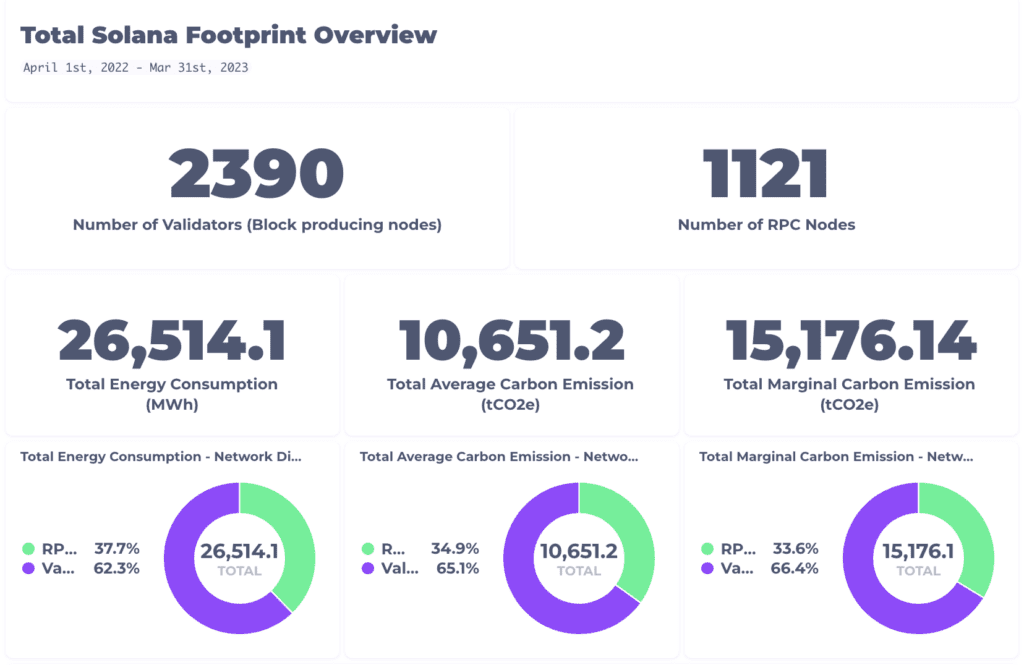Solana Introduces New Real-Time Carbon Emissions Dashboard To Limit Bad Impact
Key Points:
- The Solana Foundation has created an emissions dashboard to help people measure their carbon impact.
- According to the Foundation, it is the first major smart contract blockchain network to publicly disclose its environmental effect.
The Solana Foundation has announced real-time emissions monitoring for the Solana blockchain, which is a huge step toward sustainability. The foundation worked with Trycarbonara, a carbon data platform, to develop an emissions tracker that would be embedded in Solana nodes.

According to the foundation’s blog, this is the first large smart-contract blockchain to quantify carbon emissions in real-time. The group expects that this will spark a trend toward more transparency of carbon emissions in the blockchain ecosystem.
Solana will begin frequently updating a dedicated dashboard with statistics tracking important environmental parameters for the network, including energy usage, carbon footprint, and network power intensity, among other data, starting today. The dashboard receives real-time data from software placed on the validator nodes, although it is only updated every two weeks.
The emissions tracker, created in partnership with the carbon data portal Trycarbonara, collects information from on-chain data as well as data directly obtained from a representative sample of Solana validators.
The new dashboard also includes many emissions comparison charts so users may compare Solana consumption to a variety of other emission-producing activities.
According to Carbonara’s dashboard, Solana’s servers released 10,651 metric tons of carbon dioxide in the 12 months before April 1, 2023.
The blockchain’s new emissions data, according to the company, incorporates numerous critical elements not before assessed for blockchain technology. RPC nodes and instrumentation of the underlying hardware will be used to monitor emissions.

Moreover, emissions granularity will be supplied at the server level, and the geolocation of the validator and RPC nodes will be included. This will provide a more comprehensive picture of the network’s carbon impact.
Additionally, the new emissions statistics will contain marginal emissions, which account for the incremental emissions effect of increasing demand in relation to the overall grid supply distribution. This framework will be beneficial for assessing the environmental effect of modifications and optimizations to energy usage, and it takes into consideration the renewable energy mix of various electrical sources.
The Solana Foundation’s new emissions tracker gives a thorough picture of the network’s climate effect, as well as comparative charts that help put the Solana blockchain’s carbon footprint and individual interactions with the chain into context. This functionality will allow users to make educated, long-term choices while also working to reduce their carbon impact.

The comparison charts in the emissions tracker are a useful tool for analyzing the Solana network’s environmental effect. Users may compare their interactions with the chain to the total carbon footprint of the network to have a better understanding of their contribution to the network’s emissions.
Although most environmental critics’ crypto ire is directed at Bitcoin since its proof-of-work mining algorithm consumes the most energy of any major blockchain, smaller networks like Solana are nonetheless committed to transparency reports that shine a light on usage. Starting in November 2021, the Solana Foundation has commissioned independent third-party analyses of the Solana network’s emissions on a regular basis.
DISCLAIMER: The information on this website is provided as general market commentary and does not constitute investment advice. We encourage you to do your own research before investing.
Join us to keep track of news: https://linktr.ee/coincu
Harold
Coincu News






















